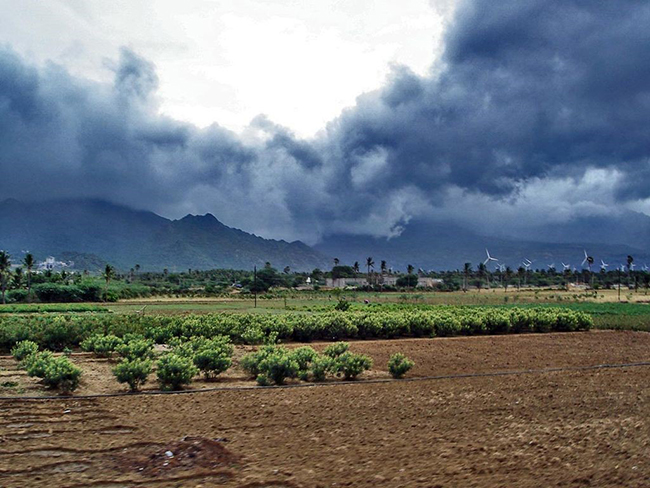Atmospher Sci & Global Chg
Research Highlights
July 2018
The Far-Reaching Effects of Tropical Moist Air
Researchers uncover a nonlinear relationship between South Asian monsoon rainfall and water vapor over the tropical Indian Ocean in Earth system models.

The South Asian monsoon supplies a large population with water for food production, energy generation, and other economic activities. "Advancing monsoon clouds and showers in Aralvaimozhy, near Nagercoil, India" by Planemad / CC BY-SA 3.0
The Science
Earth system models often struggle to accurately simulate precipitation from the South Asian monsoon and the processes that drive it. For example, Coupled Model Intercomparison Project Phase 5 (CMIP5) models exhibit a mean dry bias—a tendency toward dryness—and a large spread among models in the simulated monsoon precipitation.
Scientists at the U.S. Department of Energy's Pacific Northwest National Laboratory led a study showing that the dry bias and inter-model spread in CMIP5 models are a consequence of a nonlinear relationship between precipitation and water vapor. Results also suggest that the model bias likely causes an overestimation of the monsoon rainfall response to warming.
The Impact
The South Asian monsoon supplies a large population with water for food production, energy generation, and other economic activities. Understanding the physical processes that control the monsoon and its response to warming could help improve modeling and prediction of the monsoon system and in turn inform water planning and management efforts. In particular, this study highlights the need for better representation of tropical moist convection in Earth system models.
Summary
To improve understanding of the origins of the dry bias and inter-model spread in CMIP5 simulations, researchers examined 21 global models, three reanalyses (model-data products), and observations. They found that because of the nonlinear relationship between precipitation and water vapor in the atmosphere over the tropical Indian Ocean, simulations with more water vapor over the ocean contributed disproportionately to the weaker South Asian monsoon and large inter-model spread.
On the other hand, models that simulated less water vapor more closely matched observations of monsoon precipitation. These models also indicated monsoon precipitation is less sensitive to future warming, suggesting that the multi-model mean projection of future monsoon changes is likely overestimated. Importantly, this study identified the relationship between the vertical distribution of wind and moisture, which depends on how models represent moist convection, as a key metric for understanding model biases and differentiating model skill in simulating the South Asian monsoon precipitation.
Acknowledgments
Sponsors: This research is supported by the U.S. Department of Energy Office of Science, Biological and Environmental Research as part of the Regional and Global Climate Modeling program.
Research Area: Climate and Earth Systems Science
Research Team: Samson Hagos, L. Ruby Leung, and Karthik Balaguru, PNNL; and Moetasim Ashfaq, Oak Ridge National Laboratory
Reference: S. Hagos, L.R. Leung, M. Ashfaq, K. Balaguru, "South Asian Monsoon Precipitation in CMIP5: A Link Between Inter-Model Spread and the Representations of Tropical Convection." Climate Dynamics, early online (2018). [https://doi.org/10.1007/s00382-018-4177-4]